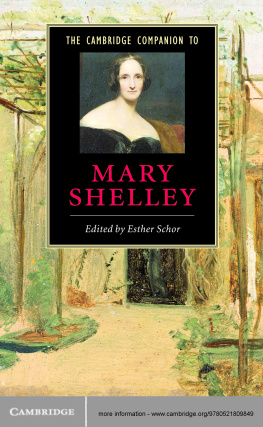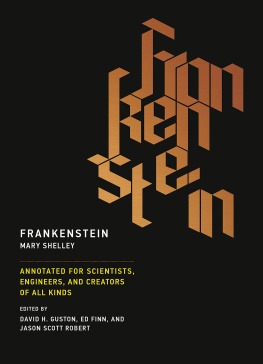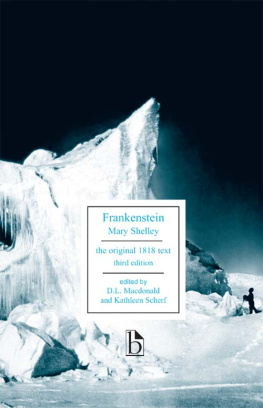MERIDIAN
Crossing Aesthetics
Werner Hamacher
Editor
Stanford University Press
Stanford, California
A LIFE WITH MARY SHELLEY
BARBARA JOHNSON
With a Foreword by Cathy Caruth
Introduction by Mary Wilson Carpenter
And Essays by Judith Butler and Shoshana Felman
Stanford University Press
Stanford, California
2014 by the Board of Trustees of the Leland Stanford Junior University.
All rights reserved.
Introduction 2014 Mary Wilson Carpenter. All rights reserved.
Barbara Johnson, , in The Other Mary Shelley: Beyond Frankenstein, edited by Audrey Fisch, Anne Mellor, and Esther Schor, pp. 258266 ( Oxford University Press, 1993). Reprinted by permission of Oxford University Press.
Barbara Johnson, , in Barbara Johnson, A World of Difference, pp. 144154 ( The Johns Hopkins University Press, 1987). Reprinted by permission of The Johns Hopkins University Press.
Barbara Johnson, , in A World of Difference, pp. 3241 ( The Johns Hopkins University Press, 1987).
Reprinted by permission of The Johns Hopkins University Press.
No part of this book may be reproduced or transmitted in any form or by any means, electronic or mechanical, including photocopying and recording, or in any information storage or retrieval system without the prior written permission of Stanford University Press.
Printed in the United States of America on acid-free, archival-quality paper
Library of Congress Cataloging-in-Publication Data
Johnson, Barbara, 19472009, author.
[Essays. Selections]
A life with Mary Shelley / Barbara Johnson ; with a foreword by Cathy Caruth ; introduction by Mary Wilson Carpenter ; and essays by Judith Butler and Shoshana Felman.
pages cm. (Meridian, crossing aesthetics)
Includes index.
ISBN 978-0-8047-9052-9 (cloth : alk. paper) ISBN 978-0-8047-9125-0 (pbk. : alk. paper)
1. Shelley, Mary Wollstonecraft, 17971851Criticism and interpretation. 2. Johnson, Barbara, 19472009Criticism and interpretation. I. Title. II. Series: Meridian (Stanford, Calif.)
PR5398.J66 2014
823.7dc23
ISBN 978-0-8047-9126-7 (electronic)
Typeset by Bruce Lundquist in 10.9/13 Adobe Garamond
Contents
Acknowledgments
The editors wish to thank a number of colleagues, students, and assistants who helped us to review the manuscript and to facilitate our work on it. Margie Ferguson generously shared with us her memories and facts, and readand enrichedthe , yielding precious, thoughtful help at the initial stages. Dr. Amy Jamgochian offered editorial insight and tirelessly facilitated the preparation of the manuscript for publication. Dane Primerano helped as a scrupulous library researcher, as a discriminating critical reader, and finally as a companion-interlocutor, first in checking and verifying correctness of quotations, later in contributing insightful feedback on the writing and the editing and in offering therebythroughout the various stages of the processunwavering support and reliable, loyal assistance (both technical and intellectual) without which this last volume could not have been brought to fruition. Eyal Peretz was, as always, a valued intellectual interlocutor, an uncompromising critic, and a generous friend and supporter. Finally, thanks are due to Werner Hamacher for his encouragement, his unconventional support, and his exquisite editorial sensitivity.
Barbara Johnsons essay English version in the collective volume, The Other Mary Shelley: Beyond Frankenstein, ed. Audrey Fisch, Anne K. Mellor, and Esther H. Schor (New York and London: Oxford University Press, 1993), pp. 258266. Reprinted by permission of Oxford University Press.
was first published as Barbara Johnson, My Monster/My Self in diacritics, Summer 1982, and later republished in Barbara Johnsons book, A World of Difference (Baltimore and London: Johns Hopkins University Press, 1987), pp. 144154. Reprinted by permission of The Johns Hopkins University Press.
was first delivered as a lecture at the conference Genre Theory and the Yale School, and published in its first version in the review Genre, Summer 1984. It was later republished in a revised version in Johnsons book A World of Difference, pp. 3241. Reprinted by permission of The Johns Hopkins University Press.
Foreword
Cathy Caruth
As the title of this book suggests, Barbara Johnson: A Life with Mary Shelley offers, in a single collection, Barbara Johnsons influential and path-breaking essays on the Romantic writer Mary Shelley written over the course of Johnsons lifetime. These essays provide essential insights into the work, and the life, of Mary Shelley, and more specifically, into the entanglement of Mary Shelleys life and writing. The original and daring works collected in this volume also sketch out a trajectory from the beginning to the end of Barbara Johnsons own brilliant career, and offer a glimpse of the inextricability of this careerof its far-reaching literary critical, theoretical, and feminist innovationsfrom the writing, and (theorized) life, of Mary Shelley.
Prefaced by a lucid description of Johnsons critical and theoretical development written by Mary Wilson Carpenter, a scholar of nineteenth-century British womens writing, the book consists of two parts, each involving essays by Barbara Johnson about Mary Shelley as well as critical interpretations of Barbara Johnsons writing by a major philosophical or literary theorist. In reading ofher life withMary Shelley. And we likewise discover the profound significance of these interwoven lives and works by recognizing the way in which Johnsons conceptual and existential imperatives are commented onand continue to resonate inthe inspiring essays of the women-critics who contribute to this volume, and who live, write, and think with Barbara Johnson.
In thus providing an inventive critical overlay of the work of Mary Shelley and of Barbara Johnson, this book affords new genealogical perspectives on late twentieth-century and early twenty-first-century critical thought. In her innovative readings of Mary Shelleys work, and in particular of her most famous novel, Frankenstein, Johnson began to shift the definition of Romanticism from its focus on great male poets to its interplay of these famous writers with the novelistic writing of Mary Shelley, who, always on the margin, implicitly (as Johnson suggested) narrated the complexity of the woman writers position in her own literary texts. During a period when the literary theoretical scene was drawing its own lines back to its Romantic forebearsparticularly in the cutting-edge deconstructive writing of the 1980sBarbara Johnson thus opened up a new line between contemporary thought and a different romanticism, one which gave birth to a genre of literary, theoretical, and (indirectly) autobiographical writing exemplified, in stunning originality, by Johnsons own work. At the same time, by drawing together Johnsons work on Mary Shelley with the work of influential feminist critics and theorists, Barbara Johnson: A Life with Mary Shelley allows us to recognize another alternative genealogy, one that binds the feminist critical writing of the 1980swhose legacy is practiced also by the feminist commentators in this bookto the newly thought Romanticism that Johnson had herself reconfigured. Proceeding from Barbara Johnsons own interest, beginning with her work on Mary Shelleys Frankenstein, in the origination of new kinds of lineagesin previously unrecognized ways in which literature, and criticism, are engendered and reproducedthis volume thus provides fresh genealogical narratives of Barbara Johnsons original vision and of an era of contemporary theory that profoundly altered our relation to our texts and to our lives.
Next page















